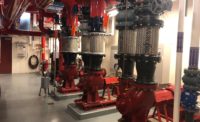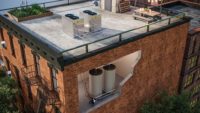The world today is defined by the urgency of climate change and the push to transition toward sustainable energy solutions, and the spotlight on heat pumps has never been brighter. One just had to walk the tradeshow floor at the 2024 AHR Expo to see how decarbonization is impacting the HVAC and plumbing industries.
“Innovation in heat pump technology, both in chillers and packaged rooftops, is unfolding rapidly and the space is incredibly dynamic,” says Philip Smyth, executive director, commercial product management, ducted systems, Johnson Controls. “The push toward decarbonization and electrification has driven extensive investments in heat pump technology. As a result, the efficiency and capacity of today’s heat pumps have significantly expanded in recent years to enable higher heating capacities and smaller equipment sizes. Commercial heat pumps can now address an increasing share of heating loads within a wider range of applications.”
Not only is the heat pump market growing, but so is size and capacity, according to Will Ward, air handler product manager, Daikin Applied.
“The growth is not only just in terms of changing from using fossil fuel heating to heat pump technology, but also the size and capacity,” he says. “We're seeing more demand for bigger heat pumps, especially in rooftop units. Not only are people converting away from gas in the traditional sense of where heat pumps have been, but it's expanding into the larger ranges of rooftops as a whole as well.”
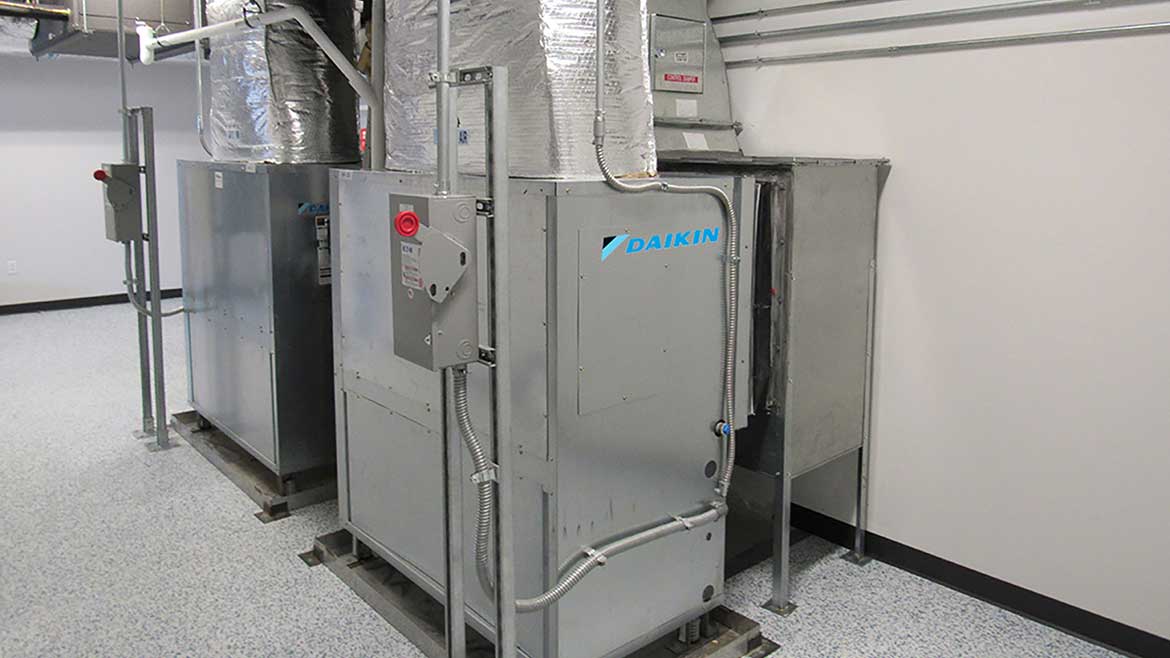
According to Daikin Applied's Will Ward, heat pump adoption is growing in big markets across the entire country. "Businesses like Amazon, Apple and Ikea are all companies looking to go into a greener future with a climate friendly set of initiatives. And as we all know, I can go to any state in the U.S. and find an Amazon distribution warehouse or an IKEA store.” | Image courtesy of Daikin Applied, Johnson Controls, METUS and Rheem
As the United States continues to move toward electrification and decarbonization, heat pump awareness is growing as a solution for buildings to increase energy efficiency and reduce greenhouse gas emissions, explains Hillary Heyerdahl, product manager, decarbonization, Rheem Water Heating Division. “Along with awareness, growth is influenced by a few factors — government regulation, incentives to shift to electric equipment, climate change concerns and a rise in consumer demand as awareness around heat pump technology grows. All of these encourage the adoption of commercial heat pumps — both for space heating and water heating.”
David Archer, vice president, commercial business, Mitsubishi Electric Trane HVAC US (METUS), agrees, noting that heat pump growth is nationwide interest in decarbonization and electrification — as a result, the commercial heat pump market is flourishing.
“Provisions of the Inflation Reduction Act (IRA) are worth mentioning because the commercial sector is being incentivized for its decarbonization initiatives,” he says. “Specifically, the 179D commercial buildings energy efficiency tax deduction offers base tax deductions to commercial building owners and designers of buildings that meet certain energy efficiency standards. Deductions work on a sliding scale of $0.50 per square foot for energy savings of 25% and up to $1 per square foot for energy savings of 50% or greater. Bonus deductions are on a sliding scale of $2.50 per square foot for energy savings of 25% and up to $5 per square foot of energy savings of 50% or greater. Depending on the size of a commercial project, and if it meets certain prevailing wage requirements, savings can be considerable.”
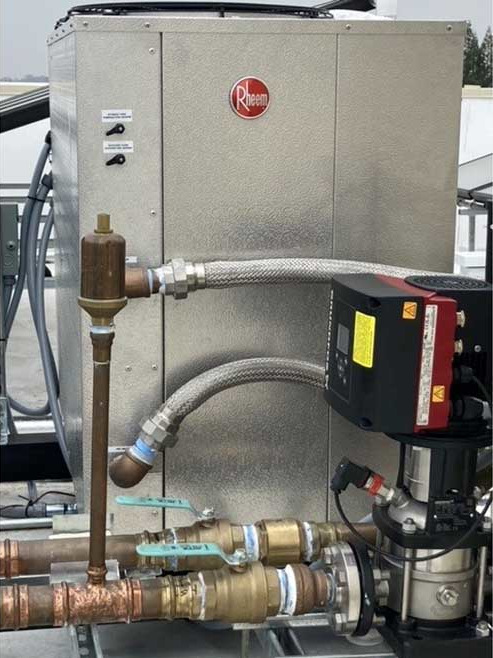
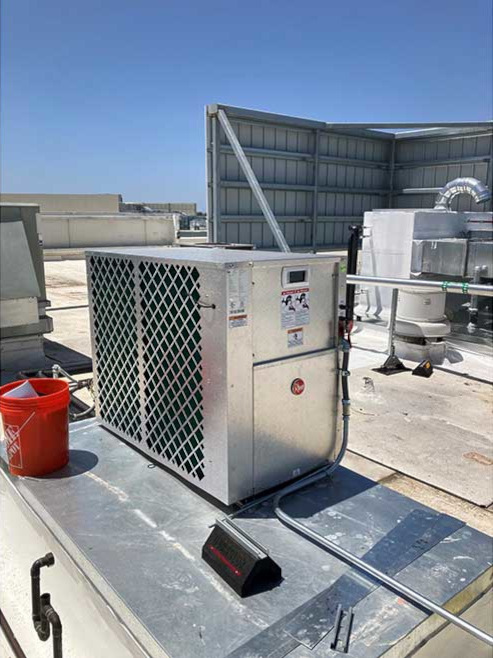
Rheem is seeing the most adoption in new construction, according to Hilary Heyerdahl. | Image courtesy of Daikin Applied, Johnson Controls, METUS and Rheem
Nationwide adoption
Historically, heat pump adoption was more abundant in regions with warmer climates. However, heat pump capacities are expanding, allowing buildings of nearly any size to benefit from heat pump integration, Smyth notes.
“In addition to regional climate legislation, state and municipal laws have played a significant role in driving heat pump integration,” he says. “California, New York and Washington were early adopters of this legislation and, in September of 2023, the U.S. Climate Alliance also announced a bipartisan coalition comprised of 25 governors to quadruple the use of commercial heat pumps within their respective states by 2030. New regulations and guidelines like these are likely to continue driving heat pump adoption in the U.S.”
Ward notes that state and local “policy and regulation” are influencing where heat pumps are being adopted.
“Essentially, we're seeing higher adoption in areas that are driven by policy and regulation as incentives. Examples are New England — Massachusetts has really invested into putting policy into place to drive electrification. New York is driving all-electric installations and is also starting to penalize the use of natural gas. Other areas that are similar are the Western regions of the country, such as Washington, Oregon, and California. Canada's also being pretty aggressive in this, too. But that doesn't mean it's limited to a handful of geographies. There are other big markets across the entire country. Businesses like Amazon, Apple and Ikea are all looking to go into a greener future with a climate friendly set of initiatives. And, I can go to any state in the U.S. and find an Amazon distribution warehouse or an IKEA store.”
Archer points to public interest and federal incentives driving the uptick in heat pump adoption.
“Regionally, legislation with decarbonization and electrification objectives are being enacted in different areas, including 24 states and 104 cities and counties across the U.S.,” he says. “An example is the Seattle Building Performance Emission Standard which was recently signed into law. The legislation is expected to decrease greenhouse gas emissions from existing large businesses by about 325,000 metric tons by 2050. This represents a 27% reduction in building-related emissions from a 2008 baseline.”
Application considerations
Installation limitations for traditional heat pumps meant heat pump adoption was simpler — and more cost-efficient — for new construction. However, according to Smyth, today’s advanced commercial heat pumps are making the transition easier for retrofit applications.
Heyerdahl also notes Rheem is seeing the most adoption in new construction.
“Often, government incentives, rebates, and tax credits for energy-efficient technologies are available for new construction projects,” she says. “These financial incentives make the costs of installing heat pump systems more attractive, encouraging builders and developers to choose heat pumps during the construction phase.
“Retrofitting an existing building with heat pumps is feasible — but it will vary building to building and can be costly,” Heyerdahl adds. “Retrofitting can require modifications to piping, electrical systems and storage requirements to accommodate the heat pump. A few concerns with retrofitting can be space requirements, since heat pumps will need room air to operate efficiently. In addition, water storage demands may be higher than those for a gas-fired system and space for additional storage tanks should be considered. Heat pumps typically require significant electrical power. Retrofitting may require upgrades to the building's electrical system to handle the increased demand. And heat loss will play an important factor for space conditioning and indoor installations. Retrofitting may prompt the need for improved insulation and sealing of the building envelope to maximize the effectiveness of the heat pump system.”
Rob Landes, system applications director, Daikin Applied, notes that a packaged rooftop heat pump can make for an easier retrofit.
“When you go from a gas rooftop to a heat pump rooftop, the most likely things impacted are the curb and the electrical feed to the unit,” he says. “Those two things can generally be addressed. They do have some cost, but it’s not the same level of difficulty as replacing a boiler with an air-to-water heat pump, which may also mean replacing all the piping along with coils or heat emitters in the building for a centralized hot water system being fed by a boiler.”
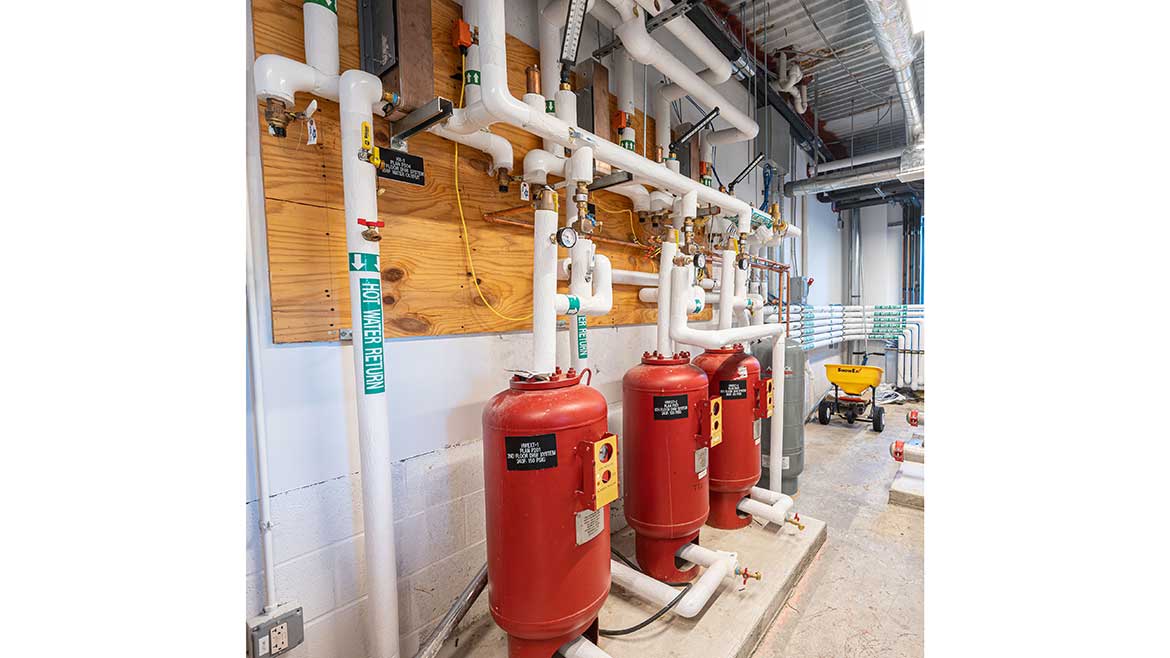
The Mitsubishi Electric Trane HVAC US (METUS) Heat2O system provides hot water to Hotel Marcel's 165-rooms. | Image courtesy of Daikin Applied, Johnson Controls, METUS and Rheem
Ward adds that Daikin Applied is adding unique and opportune solutions to help make that rooftop transition more seamless.
“Electrical infrastructure can be a challenge with a heat pump rooftop retrofit,” he says. “What we're doing and we'd like to see more of in the market, something customers would appreciate, is developing solutions that help mitigate this challenge. One example: offering dual power circuits with dedicated electric heat allows the existing power feed to remain in place to operate all other electrical loads in the unit (such as compressors, fans and controls). This solution eases installation, keeps costs down and supports a market transition from natrual gas heating rooftops over to heat pumps. Converting gas heat rooftops presents one of the largest, if not the largest, market transitions away from natrual gas heating.”
Archer adds that it’s obviously much easier to design building systems from scratch, especially for METUS’ commercial VRF heat pumps. “VRF systems are compact, come in a variety of sizes, and can include long refrigerant line lengths that can be further extended by utilizing water source heat pump VRF.”
He notes that the VRF heat pump can be equally as effective in retrofits.
“The feasibility of retrofitting existing commercial structures with heat pumps is quite high, and there are many successful examples across the country already,” Archer says. “The historic Hotel Marcel, a 110,000-square-foot rehabilitation and adaptive reuse of New Haven, Connecticut’s historic Pirelli Building, for instance, was redeveloped recently into the first Passive-house certified, zero-emission hotel in the U.S. Heat pumps helped it achieve this status, specifically Mitsubishi Electric’s CITY MULTI air-source VRF system and its Heat2O domestic hot water system.”
Resilience and reliability
There have been numerous speculations on whether outdated U.S. infrastructure can even handle the increased stress on the grid caused by electrification.
“Grid stability is a common conversation when discussing electrification — an overburdened electric grid causes power disruptions and we can’t continue to stress the system without working ways to manage demand,” Heyerdahl says. “Grid integration and demand response are opportunities to limit power disruptions. Demand response strategies enable the system to adjust its operation based on grid conditions, contributing to better management of electricity resources during peak demand and increasing grid stability. Rheem offers technologies such as low ambient back-up, built in capacity redundancy and systems including back-up fuel sources are all available to help during the colder winter months or in colder climates.”
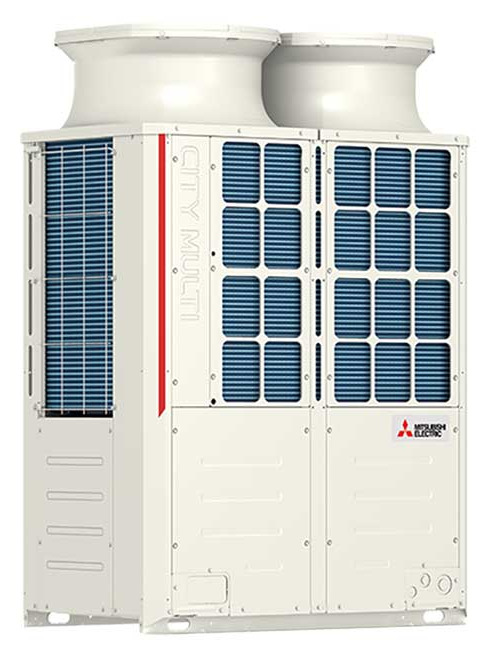
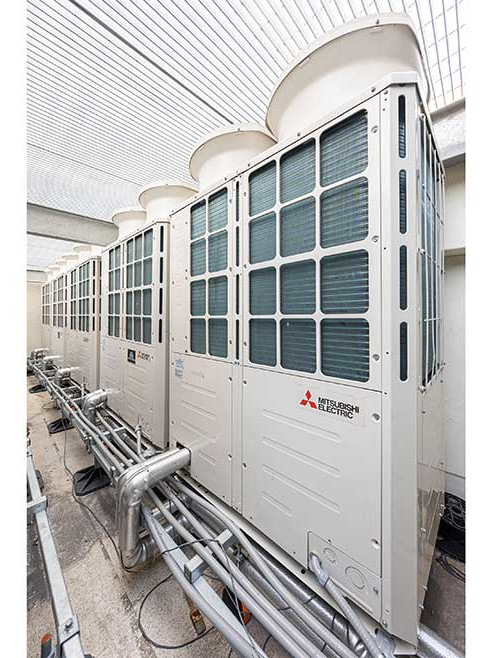
The historic Hotel Marcel, a 110,000-square-foot rehabilitation and adaptive reuse of New Haven, Connecticut’s historic Pirelli Building was redeveloped recently into the first Passive-house certified, zero-emission hotel in the U.S. Heat pumps helped it achieve this status, specifically Mitsubishi Electric’s CITY MULTI air-source VRF system and its Heat2O domestic hot water system. | Image courtesy of Daikin Applied, Johnson Controls, METUS and Rheem
Additionally, a lot of development is happening around cold climate heat pumps.
“In fact, the Department of Energy has issued a Residential Cold Climate Heat Pump (CCHP) Technology Challenge, an initiative Rheem is participating in to accelerate the deployment of heat pump technologies by supporting innovation and manufacturing,” Heyerdahl adds. “While this initiative is initially specific to residential applications, the technologies developed will expand and help with the resilience of systems in commercial applications.”
As a manufacturer, Daikin Applied has limited control over the grid, Landes notes, however, it can offer solutions that enable people to work within the confines of the grid they have, such as a dual fuel approach.
“If you either don't want to do all-electric or if your grid can't support all-electric, then considering a dual fuel arrangement where you use gas on those coldest of days when the grid is going to be the most taxed is an alternate approach,” Landes says. “I don't see any way around addressing the grid if we want to get to a point where we have a 100% electric future, because even if we were to have heat pumps that could operate down to -20 or -30° F, you still have reduced efficiency of the heat pumps at those conditions compared to normal. So you're still going to have the highest heat load in the building and reduced efficiency of the heat pump at the time when the worst-case scenario at that coldest ambient temperature. So in order to support electrification, that's sort of the bare minimum that the grid has to support. But while the grid is scaling up, a lot of folks are looking at it and saying, 'Well, it makes sense to decarbonize by leveraging the heat pump during mild temperatures and then keep gas as a backup on those coldest days.'”
“From a manufacturer's perspective, one thing we can control is what our equipment is capable of,” Ward adds. “If a customer wants to use a dual fuel arrangement for backup on the coldest day of the year, that’s a great approach. But one thing I’d like to see more of in the market on dual fuel units is emphasis on how they are controlled. Some approach dual fuel as an either or situation, meaning I can either operate my heat pump or gas heat. Our approach is I can operate my heat pump, but it’s not able to deliver quite as much heat as I need, so I’m going to simultaneously use my gas heat and trim. That gives you a much more carbon-friendly solution year-round. Also, when the grid is taxed, the utility can tell you, 'We want you to use less electricity, go all gas.' And you're able to adjust right then and there.”
Cold climate heat pumps are an important advancement in the market, Archer notes.
“Heat pumps were previously considered less than effective in heating environments where outdoor temperatures fell below 27° F,” he says. “With significant innovations in technology, modern heat pumps are mainstream and effective in the negative Fahrenheit range. For instance, Mitsubishi Electric’s all-climate Hyper-Heating INVERTER heat pumps offer 100% capacity at outdoor temperature of -5° F and operate in environments below -20° F. Although unnecessary in many commercial buildings, some of our products can integrate with other heating sources, including electric heating, hot water heating and gas heating, to ensure indoor comfort in existing systems or in the coldest climates.
“Continuous improvement is a core focus of business at METUS, particularly as we evaluate and make sure we can meet these conditions,” Archer continues. “We are constantly working on creating new products to meet tomorrow’s heating and cooling needs. Additionally, our INVERTER-driven, VRF heat pumps easily load shed and compressors soft start for successful integration with generators. Additionally, load shedding can be integrated in stages in coordination with site utilities to reduce load when necessary while maintaining some degree of heating and cooling.”
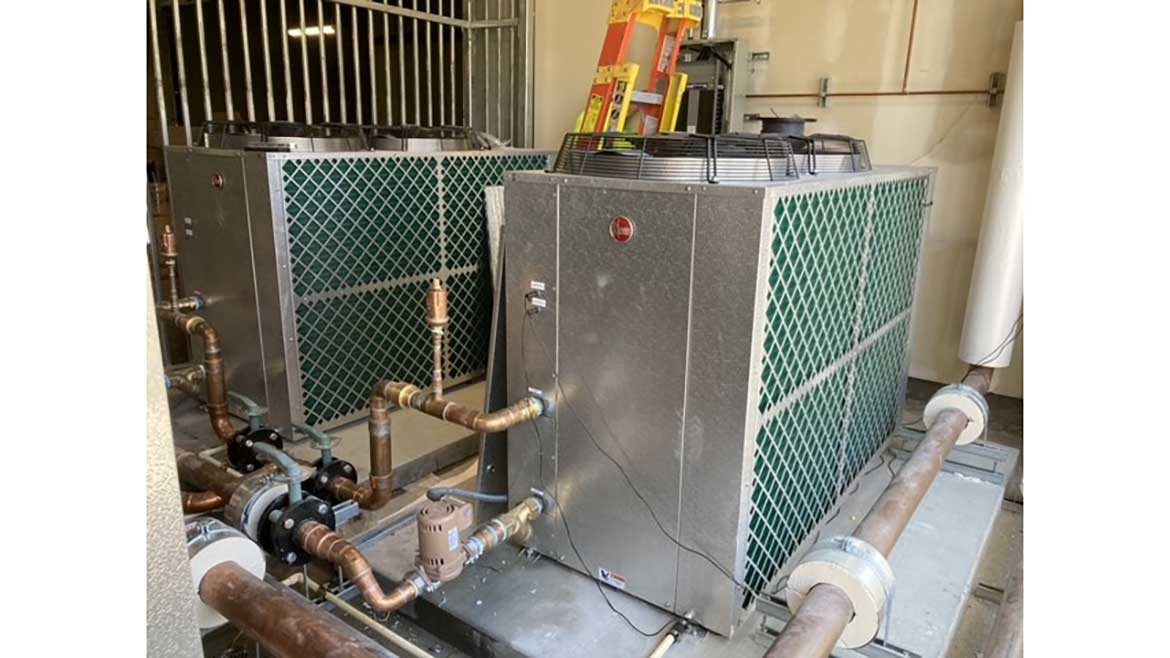
Rheem is seeing the most adoption in new construction, according to Hilary Heyerdahl. | Image courtesy of Daikin Applied, Johnson Controls, METUS and Rheem
What’s next
Many experts believe heat pumps are the future of heating and cooling, and the plumbing and HVAC industries will begin to see more and more adoption in markets all over the U.S.
“As market and regulatory forces continue to increase demand for heat pumps, the industry will see an increasing range of heat pump systems, performance capabilities and digitalization options,” Smyth explains. “To meet this growing demand, manufacturers must also adjust to ensure the industry can achieve both 2030 and 2050 sustainability benchmarks.”
Johnson Controls has committed to optimizing three U.S.-based manufacturing facilities to enable swift rollout and advanced testing of next-generation heat pumps, he adds. “Upon completion, the project will enable the production of over 200,000 electric heat pumps per year.”
Heyerdahl agrees, noting that as more stringent environmental and energy regulations are adopted, commercial heat pumps will be key products in reducing energy use and greenhouse gas emissions.
“Rheem is focused on playing a critical role in education and awareness of heat pump products for various buildings,” she says. “There is only room for more advancement and innovation toward cleaner energy solutions.”
The market can expect to see better heat pump technology, expanded offerings and more market education over the next few years, according to Ward.
“If we're truly going to decarbonize, we've got to get creative in a lot of different ways,” he says. “If we're going to go all electric, we have to be aggressive and not just rely on the same old thing because we're going to get the same old results. That means creative thinking, educating the market, educating ourselves and developing innovative technology. Consider twhat happened during COVID, for example. The prevailing approach was to put as much fresh air into the building as possible, which decreases efficiency and exaggerates the challenge. But there are ways to clean and recirculate indoor air versus diluting contaminants with more outdoor air. Changing standard practices can work if we can get our markets educated, get people to understand what we're talking about and start leveraging this new technology. It's going to be one of the ways that we can help accelerate the transition.”
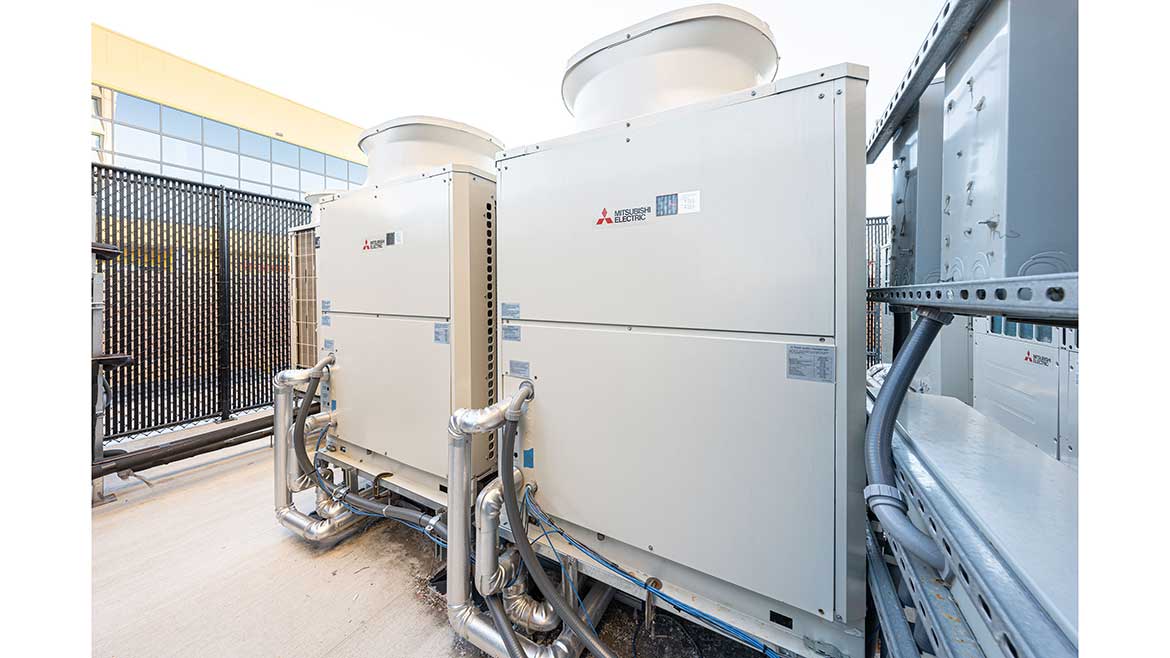
METUS HEAT2O is installed at Hotel Marcel in Connecticut. | Image courtesy of Daikin Applied, Johnson Controls, METUS and Rheem
Landes adds that it’s important to adapt our systems for heat pumps rather than adapting heat pumps for systems.
“We need to design our systems in a way that's thoughtful about leveraging the good qualities of heat pumps and minimizing the downsides, or the things that don't fit well with our traditional designs,” he says. “We can either try to shoehorn the heat pump in there, or we can adjust our designs to be thoughtful about how we do this. If we were drawing on a fresh, clean sheet of paper, how we design a system for a heat pump would look different than how we would designed it for fossil fuels many years ago. Adapting our systems to be thoughtful and mindful of what exactly is an optimized system going forward, and how does that look different from what we've always done — that's a good theme that applies to many different aspects of electrification and decarbonization.”
Archer notes that all-electric heat pumps have been the fastest growing segment in HVAC for several years.
“I expect this trend to continue due to consumers discussing and embracing heat pumps, as well as governmental legislation and incentives driving adoption of more energy-efficient, electric HVAC systems,” he says. “Our society more broadly demands greater efficiency, greater comfort, and greater sustainability each year. If you are not considering modern heat pumps, you may be missing an opportunity to utilize some of the best tools in the HVAC industry!”


